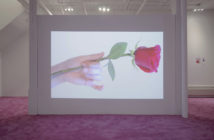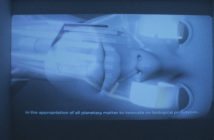October 11, 2012
Silence
Toby Kamps and Steve Seid, with a contribution by Jenni Sorkin
Published Aug 20, 2012
112 p., 90 color illus.
ISBN: 9780300179644
$45.00
If you are like me this October, you will be spending most of the month in Boston immersed in the din of work and play, with occasional noise of a football game. Luckily for us, however, there is a retreat in the form of the Silence catalogue. An exhibition of paintings, sculpture and video that explores silence as an artistic theme, medium and subject in modern and contemporary art, Silence is on view at the Menil through October 21 before traveling to the UC Berkeley Art Museum/Pacific Film Archive in 2013; the catalogue includes essays by Toby Kamps, curator of modern and contemporary art at the Menil, Steve Seid, video curator at the BAM/PFA, and Jenni Sorkin, assistant professor of Contemporary Art and Critical Studies at the University of Houston. Clothed in grey woven fabric, the catalogue itself is a subtle reminder that silence is never necessarily still, empty, or even real.
With images of exhibited works plated before the essays, the catalogue progresses as you might wander through the exhibition space, skipping and then returning to certain works. These plates aren’t arranged chronologically, but rather thematically. Silence takes for its "silent big bang," as Kamps writes at the start of his essay, John Cage’s epic 4’33. Its first iteration a 1952 performance in which an concert hall audience, present to hear a 26-year-old prodigy pianist listened instead to their own aggravated noises, 4’33 is punctuated by the pianist opening and closing the instrument’s cover at the start, between the composition’s three movements, and at the end of the piece. Inspired to explore the noise of silence after his 1951 visit to an anechoic chamber at Harvard, Cage’s 4’33, as Kamps observes, became a catalyst for revolutionary music and art from mid-century onwards, but is rooted in a pre-modern interest in silence in all art forms.
In his essay, appropriately titled (…), Kamps explores the myriad of art made in 4’33’s wake, particularly focusing on how types of silence inform radically different types of artistic output. Kamps writes that "Silence examines a few of the many attempts in which artists have employed the absence of sound or speech over the last century: as a symbol, as a phenomenon, as a memorial device, as an oppressive force, and as something to be inhabited and explored through performance." Guiding readers throughout the included works with incisive enthusiasm, Kamps astutely links modern precedents with contemporary trends within subsets of silence in art, such as "Synesthetic Silence," "Symbolic Silence," "Sonic Silence," and so on. Perhaps this is never more poignant than in "Memorial Silence," as Kamps discusses how Doris Salcedo, Bruce Nauman, the collaborative Gran Fury, Kurt Mueller and Jacob Kikegaard represent, protest, remember and observe the silence of death in their work. But, as Kamps remarks, we don’t know if death is actually silent, as we can only represent it as something that we--the living--haven’t known. In finishing his essay, Kamps writes that as Cage observed, "silence is a distinctly human phenomenon—something that must be imagined to be experienced."
In "A Prolonged Silence: John Cage and Still After," Jenni Sorkin situates 4’33 within the context of postwar Abstract Expressionism as well as nineteenth century thought, suggesting that the piece is as much steeped in the idea of performance as painting practice as it was in Zen and "Wagnerian Gesamtkunstwerk," or a complete work of art. "Ultimately, Cage’s silent piece functions as an inaugural moment in the history of postwar art—its active engagement of the audience is itself an aural work-in-progress that continues to provide an evolving confluence of sound, dissonance, and contact, highlighting the tensions that invariably exist between an audience, a performer, and a performance," writes Sorkin. This essay, alongside Steve Seid’s The Sounds of Silence: Some Thoughts on Silence in Experimental Film and Video Practice," underscores the essential relationship between silence and performativity. In his essay, Seid delineates the history of film and video, noting the emergence of sound in film as artificiality, introduced only for realism’s sake. Placing this interest in Realism within an art historical framework that begins with Renaissance painting, Seid writes "while Hollywood-inspired cinema emphasized the refinement of storytelling with a de facto dependence on the accurate image, the emerging American avant-garde drew inspiration from the materials themselves and tore the image from its roots in reality." Relishing in the limitations of the medium, mid-century filmmakers exploited silence or sound in order to create poetic, abstract and painterly works that reject narrative as an appropriation from literature, and Realism as restricting. Still, however, as both Sorkin and Seid suggest, the experience of silence is dependent on audience. Just one sneeze, cell phone or sigh can upend silence, relegating it always as something to be suggested rather than actually realized.




